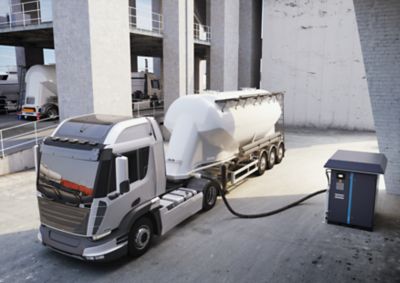How is industrial oxygen produced?
Generating oxygen on-site is not only reliable and cost-effective but also crucial for various industrial applications. But how is industrial oxygen produced, and how is oxygen manufactured to meet these needs? The answer lies in oxygen generation technologies that allow businesses to extract high-purity oxygen directly from ambient air. From pressure swing adsorption (PSA) to membrane systems, various methods are used to produce oxygen for industrial use.
In this guide, you'll discover how oxygen is manufactured, which technologies make it possible, and the benefits of on-site oxygen production.
How does an oxygen generator work?
Oxygen generators are designed to extract oxygen from ambient air. Since air is a mixture of gases, mainly nitrogen (about 78%) and oxygen (about 21%), the main goal is to separate oxygen molecules from the rest. Different technologies, such as PSA, VPSA, membranes, or chemical systems, can be used to isolate and concentrate oxygen, depending on purity and application needs.
Pressure Swing Adsorption (PSA)
Pressure Swing Adsorption (PSA) is the most commonly used technology for generating industrial oxygen. PSA is valued for its reliability and efficiency in on-site oxygen generation as the process ensures a continuous supply of oxygen at purities up to 95%.
Typically used in smaller applications:
- Medical
- Industrial applications such as metal cutting, welding
- Wastewater treatment
- Aquaculture
The process uses a pair of pressure vessels filled with carbon molecular sieve (CMS). This porous material effectively traps nitrogen, carbon dioxide, water vapor, and other trace gases from compressed air, while allowing high-purity oxygen to pass through. As one vessel adsorbs, the other undergoes regeneration by depressurizing and releasing the captured gases, enabling continuous operation.
Vacuum Pressure Swing Adsorption (VPSA)
VPSA is an oxygen generation technology that works similarly to PSA but uses a vacuum during the regeneration phase, reducing energy use and improving efficiency. It's commonly used in large-scale operations where energy savings are important.
Typically used in larger applications:
- Steel and petrochemical industries
- Biogas production
- High-capacity production with energy efficiency focus
Membrane separation technology
This method uses semi-permeable membranes to filter air. Nitrogen and other gases pass through the membrane walls differently than oxygen, allowing for a stream of oxygen-enriched air. The purity is lower (30–40%), but the setup is simple and compact.
Used in:
- Wastewater treatment
- Nitrogen reduction processes
- Applications not requiring high oxygen purity
Chemical Oxygen Generators
Chemical oxygen generators produce oxygen through chemical reactions, such as decomposing sodium chlorate. These systems are compact and often used in enclosed or emergency environments.
Used in:
- Emergencies (aircraft, submarines)
- Portable oxygen supply in confined spaces
Key benefits of on-site oxygen production
Industrial applications of oxygen generators
Oxygen generators are used in a wide range of industrial applications due to their efficiency and cost-effectiveness.
Here are a few uses of industrial oxygen:
- Metal production: Oxygen aids in burning fuel at higher temperatures, essential for processes like steelmaking and welding.
- Wastewater treatment: Oxygen improves bacterial efficiency in breaking down organic materials.
- Glass manufacturing: Oxygen-enriched flames produce higher temperatures, enhancing glass quality.
- Aquaculture: Increased oxygen levels in water boost fish growth and health.
- Medical facilities: Reliable oxygen supply for respiratory therapies and emergency care.
Safety considerations checklist
Remember to follow safety protocols when producing and storing oxygen on-site:
- Ensure proper ventilation in generator rooms and enclosed spaces.
- Keep oxygen systems away from flammable materials.
- Inspect filters and valves regularly.
- Use alarms to monitor oxygen purity and pressure levels.
- Wear PPE such as insulated gloves, safety glasses, and face shields.
Note: Industrial oxygen should not be used in a medical emergency unless it meets medical-grade standards.
Choosing the right oxygen generator
Choosing the right oxygen generator depends on your required purity level, usage volume, and operational needs. On-site oxygen generation, especially using PSA (Pressure Swing Adsorption) technology, is often the most cost-effective and reliable solution, without the need for deliveries.
To select the most suitable system, consider the following:
- purity requirements (e.g., medical vs. industrial use),
- flow rate (oxygen needed per minute/hour),
- space and maintenance (available installation area and servicing capacity),
- budget (upfront and long-term costs),
- and safety regulations (compliance with relevant industry standards).
While bottled or liquid oxygen may suit specific short-term or high-volume needs, on-site systems offer greater autonomy, efficiency, and safety across applications like healthcare, aquaculture, and manufacturing.
Frequently asked questions
What is industrial oxygen?
Industrial oxygen refers to oxygen used for manufacturing, processing, or other technical applications. It typically has a purity of 90–95%, depending on the production method. While similar in composition to medical oxygen, it is not certified for human consumption unless tested and approved according to specific health standards.
What is an oxygen generator?
An oxygen generator is a device that separates and concentrates oxygen from ambient air to provide a continuous supply of high-purity oxygen for industrial use.
Unlike other gas generation systems—such as nitrogen or hydrogen generators—oxygen generators are optimized specifically to meet the oxygen demands of industries like metal processing, glass production, and wastewater treatment. These systems enable on-site generation, reducing reliance on external suppliers and increasing operational efficiency.
What is the difference between an oxygen generator and an oxygen concentrator?
An oxygen concentrator is a smaller, portable version of an oxygen generator, typically used for medical applications. Generators are larger and serve industrial needs.
What is the difference between industrial and medical oxygen?
Industrial and medical oxygen differ in their applications, certification standards, and delivery methods:
Medical oxygen: Must meet strict purity and cleanliness standards (USP or pharmacopoeia grade).
Industrial oxygen: Used in controlled environments and manufacturing. Not certified for medical use unless processed accordingly.

